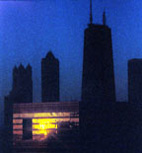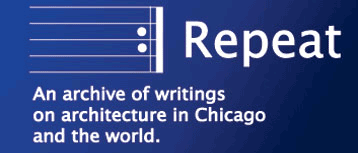

  |
||||
|
|
Freedom's Just Another Word for Another New Museum -by Lynn Becker [April 19, 2006] New York couldn't get its Freedom Museum off the ground. Chicago's is already open.
|
|
||
|
But let's talk about the architecture for a moment. The museum is housed in a low-rise annex to Hood & Howells' landmark 1925 Tribune Tower that had a Hammacher-Schlemmer store as its most recent tenant. Despite being studded, like the Tower itself, with fragments taken from many of the world's most famous buildings, the smaller building has a grace and modesty that provides a good foil to its adjoining Mag Mile Rouen wannabe. The 10,000 square foot facility, designed by VOA Associates, is a two story space dominated by a large central The atrium is all white, with drop ceilings. The open ceiling and exposed ductwork of the second floor is painted black. There's a couple of incongruous - and pointless - appliqués of travertine. And there's a bit too much gray. When it serves as a slim frame for the exhibits, it's tolerable, but as the predominate color in the small first floor Freedom Theater, it's dark, drab and depressing in an uber-corporate kind of way. It's the exhibits themselves, designed by Gallagher & Associates, that enliven the space with vibrant color - a glowing emerald The $5.00 entry fee is less than the $7.00 than the museum's executive director David Anderson was talking about last January, and on the first Saturday after opening, there was a steady stream of visitors, although the Freedom's Future exhibit, a roomful of computers offering interactive quizzes, remained completely empty during the entire time I was there. Another exhibit covers the "Some 30% of high school students in one poll," says Anderson, "believe that newspapers need to obtain permission from the government prior to publishing stories. It sends a chill down my spine. Our intention is to avert apathy, and educate students and adults as they come through the museum, so that we can reverse what we see as an unfortunate trend." Add in general public apathy to the hostility to the press and mania for secrecy on the part of the current administration of George Bush (endorsed, of course, by the Tribune in both elections), it's clear the museum has its work cut out for it, and it labors hard to make the installations interactive and user-friendly. The Closer to Home exhibit allows you to listen to banned records from throughout the 20th century, from Billie Holiday to Screaming Jay (I put a spell on you.) Hawkins You can also vote your opinion on several landmark cases of broadcast censorship (although you don't actually get to see or hear any of them) that range from Uncle Miltie (Berle),to George Carlin's seven dirty words, right up to Janet Jackson's wardrobe malfunction. I have to admit being smitten by the furor over Mae West's 1937 appearance on radio's number-
Join a discussion on this story. © Copyright 2006 Lynn Becker All rights reserved.
|
||||